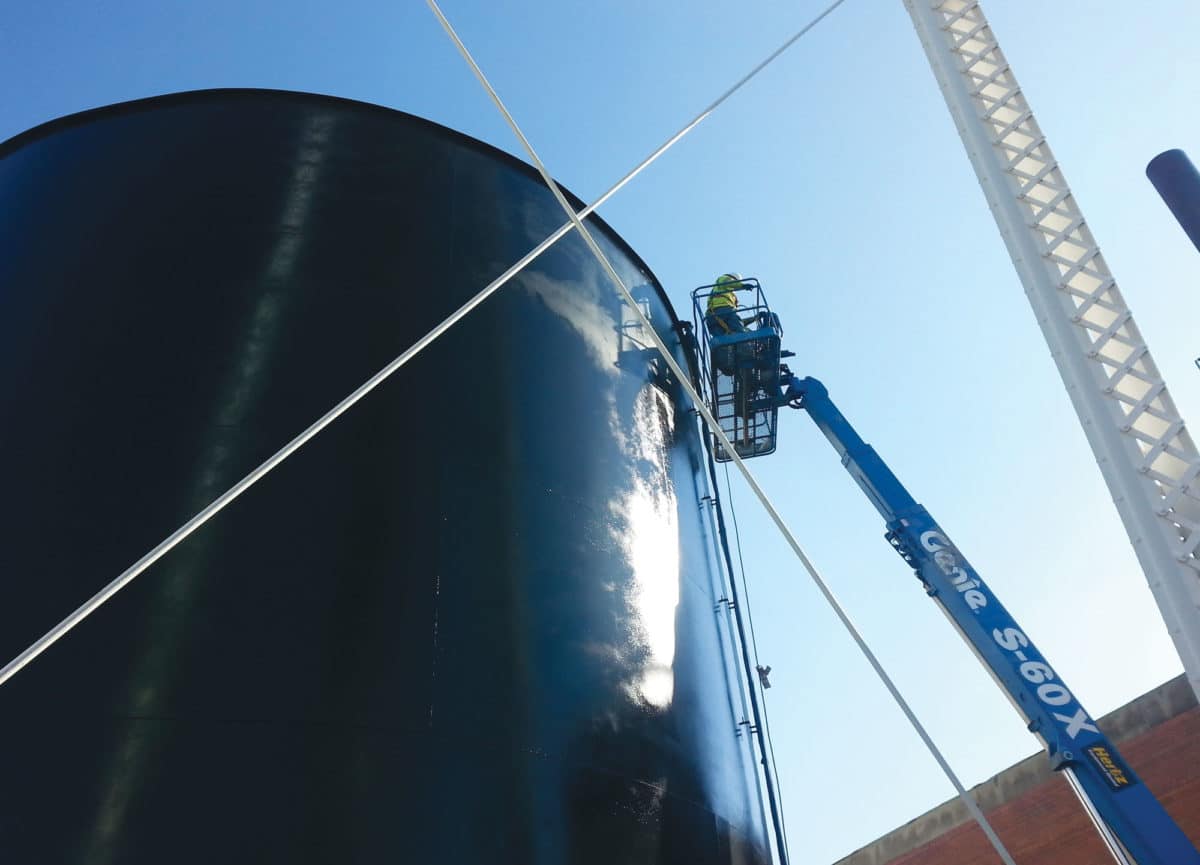
[Photo: Courtesy of Absolute Weather Shield]
Water damage to a building can be both costly and all too common. In just minutes, water can destroy property and render assets useless.
A study from the EPA looking at 100 public and commercial U.S. office buildings showed 85% of buildings previously had some type of water damage.
While there are a variety of solutions on the market to help protect buildings and assets, installation can be costly, with some products requiring crews of 10-plus workers, says Nik D’Annunzio, vice president of operations for Absolute Weather Shield.
That’s why Absolute Weather Shield products were created. The spray applications allow a crew of three to install more than 1,000 square feet an hour of rubber waterproofing—more than 10,000 square feet a day. “It is a very economical option for contractors. This is big because construction labor is probably one of the hardest jobs to fill at the moment,” D’Annunzio says.
The cold fluid, water-based application is safe for the environment and does not require any special ventilation when applied. It contains no VOCs and has a life of 10-25–plus years, thus cutting down on environmental waste. “Waterproofing keeps your indoor environment dry and healthy,” D’Annunzio says.
The self-repairing product can stretch and contract with the building or other structure it’s applied to and will adhere to any surface. It’s also quick drying, with 90% setting instantly, and the other 10% taking 4-12 hours, depending
on weather conditions.
Here are some ways Absolute Weather Shield products can keep buildings dry and assets safe:
1. Apply D-Max Rubber Shield to an existing roof system to double the life of the roof.
The durable D-Max membrane—a combination of modified rubber and emulsified asphalt—self-seals when punctured, preventing a small hole in the roof from leading to a big problem.
2. Reduce building temperature and cooling costs in warmer climates by using the tan roof spray.
The company is also developing a white roof application. The lighter color is designed to reflect sunlight while also keeping water from entering the building.
3. Use D-Max Leak Response Sealer to permanently repair any leaks in roofing or the foundation of a structure.
The elastic, monolithic membrane seals defects with no seams, thus preventing the need for further repair. The leak-sealing material can be sprayed on. It’s also available to brush on for smaller surfaces.
4. The D-Max products can be applied around window seals to help prevent leaks.
The products are designed to lock out moisture and other contaminants, especially in areas where adverse weather conditions may cause damage.
5. A penetrating concrete sealer product can be used on all concrete, including concrete floors to keep them
from cracking.
The product PLS-107P Sealer blocks and reduces vapor emissions while leaving concrete breathable. It purges soluble chlorides and prevents reentry into the structure, and it cures and chemically hardens in one application.

Absolute Weather Shield has solutions to reduce
your building’s temperature and cooling costs. [Photo: Courtesy of Absolute Weather Shield]
6. The Absolute Weather Shield Vapor Barrier can be used to prevent the transfer of unwanted compounds from one space to another.
This product has been used by farmers to seal silos and keep conditions ideal.
7. Keep tanks or other fluid-filled structures from leaking by installing D-Max Rubber Shield on the inside of the tank.
The product is free of VOCs, anti-corrosive, and resistant to non-petroleum based chemicals. It has commonly been used as a pond liner.
8. The rubber technology will adhere to any surface material—including surfaces that are wet or damp—and therefore can be a solution for keeping moisture out of metal elevator shafts.
9. The foundation of an existing structure can be a common place for water to enter.
Applying D-Max Rubber Shield to the foundation’s interior or exterior can seal any existing leaks and envelop the structure to prevent future problems. The product is recommended for use above grade.
10. Installing the D-Max Waterproofing Plus System—consisting of a fluid-applied, rubberized asphalt membrane and dimpled membrane drainage system—on concrete, wood, or foam will help stop any water from draining into the structure.
It can be used on new and existing structures, both interior and exterior, and in all climates.
Learn more about Absolute Weather Shield and catch up on more gb&d roofing stories.
